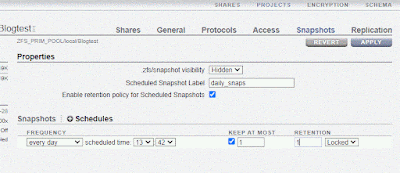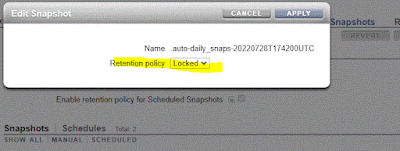In this post I will go through what happens with Archive log Backupsets sent to the ZDLRA through log sweeps.
When you implement ZDLRA you have 2 choices in backing up archive logs.
1) Use real-time redo transport (RRT) which is the same mechanism that is used to send archive logs to a standby database.
2) Use traditional log sweeps (RMAN) that pick up the archive logs and send them to the ZDLRA as backupsets.
Today I am going to go through the second option, using RMAN log sweeps.
Before I go into detail please refer to this MOS note to ensure you understand best practice for backing up a database to the ZDLRA.
RMAN best practice recommendations for backing up to the Recovery Appliance (Doc ID 2176686.1)
As of writing this post, the best practice is
backup device type sbt cumulative incremental level 1 filesperset 1 section size 64g database plus archivelog filesperset 32 not backed up;
When you execute the best practice command, there are 2 pieces to this backup script.
Database Backup - The best practice is filesperset=1 and section size 64G. This ensures that a large datafile backup (big file) is broken up into pieces, and each backup piece contains only a single datafile. This allows the virtualization process to start as soon as each backup piece is received
Archivelog Backup - Best practice is to use filesperset=32 and only backup archivelogs that have not been backed up.
Now to walk through the archive log backup process:
RMAN will create a backupset of 32 archive logs. This backupset will be sent to the ZDLRA (through the libra.so library) and will be written to physical disk on the ZDLRA. The RMAN catalog on the ZDLRA will be immediately updated with the location of the backupset.
Since there is no processing done on the ZDLRA once received (beyond what the RMAN client does), the file is written "as is" on the ZDLRA.
So what why do I point this out ? As you may know the ZDLRA compresses Datafile backups received, but it does not compress archivelog backupsets through RMAN. If you want your archivelog backupset compressed (that came to the ZDLRA through an RMAN log sweep) you must perform compression through RMAN before sending the archive logs.,
There are a few items to think about before you rush into immediately compressing archive logs.
The first of which (and probably most important to your company) is that RMAN compression, other than basic (which is NOT recommended) requires the ACO (advanced Compression) option (license). If the databases you support are NOT licensed for ACO usage, then you should stop right here, and consider using real-time redo. Real-time redo can use all levels of compression without the ACO because the compression is done on the ZDLRA. This will be my next blog post.
#1 - ACO is required for RMAN compression. Use real-time redo to compress on the ZDLRA without the ACO license
The second thing to think about is what level of compression. Below is some example compression ratio AND timings that have been achieved to give you an idea of the differences. Of course every one's data is different, so your mileage could vary. This does give you an idea however.
BASIC - The elapsed time is 5x longer than it is for NOCOMP. I would absolutely not recommend using BASIC compression.
LOW - The elapsed time was actually less than NOCOMP, most likely due to sending less traffic. The backup ratio was roughly 2:1 giving a great balance of similar execution time and reasonable compression
MEDIUM - The elapsed time was triple (3x) that of LOW or NOCOMP. The compression ratio was slightly better, but not significant.
HIGH - The elapsed time was 24x longer than it is for NOCOMP, and the compression ratio was only slightly better. I would absolutely not recommend using HIGH compression
#2 - LOW compression offers the best balance between elapsed time, and compression ratio.
As I point out that compression of archive logs is a good thing, there as a BIG CAVEAT to this. The ZDLRA has its own compression of datafile backups. The ZDLRA compression is of each individual block, NOT the backupset. Because of this RMAN compression of datafiles is not recommended, and if TDE is implemented this will cause backups not to virtualize. The 2 items are.
- The ZDLRA will uncompress the RMAN backupset and recompress the blocks once virtualized.
- TDE data will not be virtualized since RMAN compression re-encrypts the backupset.
#3 - DO NOT compress datafile backups.
The 4th item associated with the compression of archive log backupsets is replication. The replication of archivelogs on the ZDLRA is the "cascade" of backupsets. The backupset containing the archive logs are sent to the downstream "as-is". If you compress the archive logs with RMAN, then they get replicated compressed. The compressed backupsets not only use less network traffic when replicating, but they will also be stored on the downstream compressed.
#4 - Compression of archive logs means less network traffic with replication.
The 5th item associated with the compression of archive logs is validation on the ZDLRA. Compression of archive logs comes with a slight cost, and this is one of the trade-offs. The ZDLRA (as you might know) does a "restore validate" of all backups on the ZDLRA on regular basis (typically once a week). In order to validated archivelog backupsets, these backupsets need to be uncompressed. The uncompression of archivelog backupsets uses CPU on the ZDLRA and the higher the compression, the greater the overhead of this process. Believe it or not, weekly validation is one of the most intensive tasks performed on the ZDLRA. Using LOW compression has minimal impact on CPU during validation and is recommended unless space is at a premium and MEDIUM compression can be tolerated.
NOTE: This can be monitored in the SAR report by looking at the VALIDATE task. You should see VALIDATE tasks completing, and when looking at executing tasks, the MIN_CREATION should with a day or 2 of executing the SAR report. If the MIN_CREATION data is more than few days old, VALIDATION tasks are not keeping up and implementing compression will exasperate this situation.
#5 - Validation requires uncompressing archivelog backupsets, so be careful of too high a level of compression.
The final item associated with the compression of archive logs is the recovery of the database using archivelog backupsets. During a recovery operation, any archivelogs restored through RMAN will have to be uncompressed. This uncompression may affect recovery time. LOW gives the best tradeoff since the elapsed time to uncompress is minimal. If the network is saturated, restoring compressed archivelogs (which are typically 50% the size) may actually help with recovery time.
#6 - The DB host will have to uncompress archivelog backupsets during recovery. This may affect recovery time.
Now the question is.. How do I put this together to get LOW compression of archive logs AND not compress datafiles?
This is how it can be done.
1) Enable RMAN LOW compression option.
RMAN> CONFIGURE DEVICE TYPE 'SBT_TAPE' BACKUP TYPE TO BACKUPSET;
2) Ensure that compressed backupsets are NOT used by default
RMAN> CONFIGURE DEVICE TYPE 'SBT_TAPE' BACKUP TYPE TO BACKUPSET;
3) Daily incremental level 1 Backups.
run
{
backup as compressed backupset filesperset 8 archivelog all not backed up delete input;
backup as backupset cumulative incremental level 1 filesperset 1 section size 128G database;
backup as compressed backupset filesperset 8 archivelog all not backed up delete input;
}
4) Periodic log sweep Backups.
run
{
backup as compressed backupset filesperset 8 archivelog all not backed up delete input;
}
I am hoping this gives you everything you need to know about using RMAN log sweeps with the ZDLRA and you can decide if you want to use compression of archivelogs during those sweeps.










































